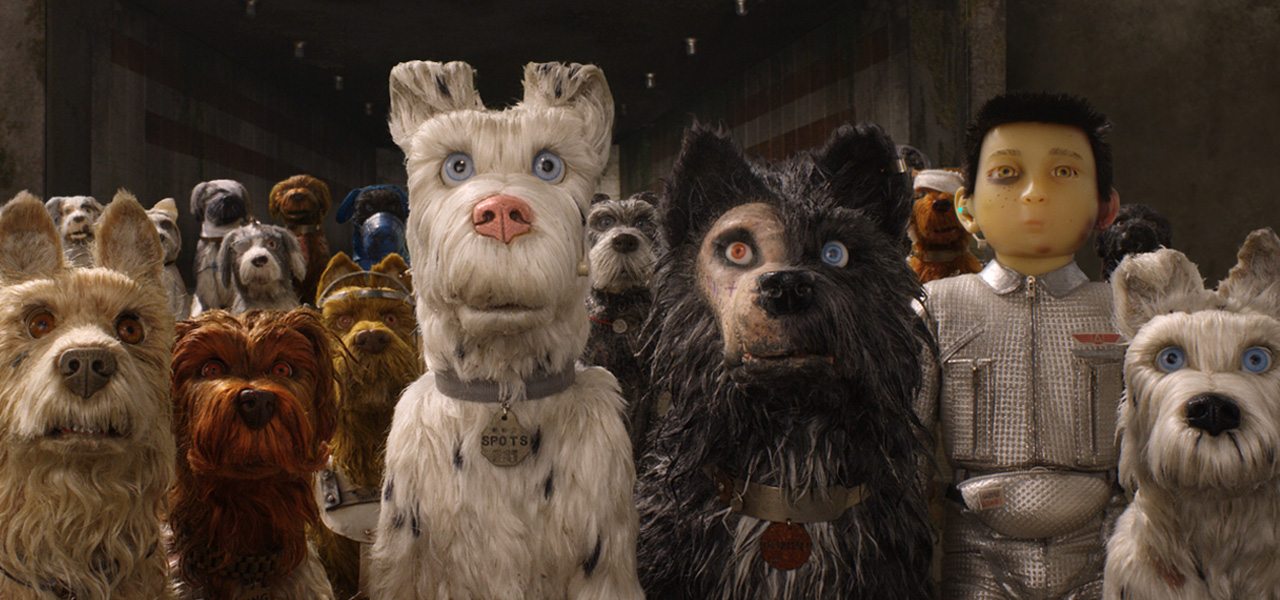
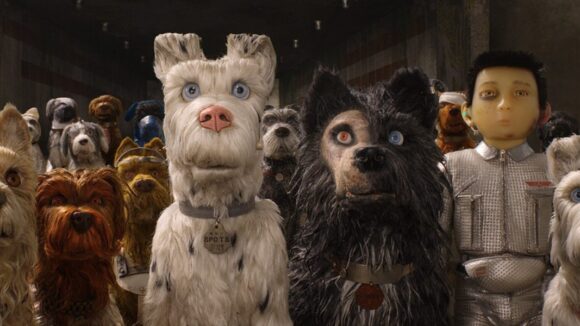
Stop-Motion Cinematography: Q&A With ‘Isle of Dogs’ DOP Tristan Oliver
Stop-motion cinematography is not something we always get to cover here at Cartoon Brew with stop-motion animated film releases. But that work, of course, is crucial in bringing to life intricately designed sets and puppets and allowing animators to craft stop-motion scenes.

The cinematography of Wes Anderson’s Isle of Dogs was overseen by director of photography Tristan Oliver. He’d worked with Anderson before – on Fantastic Mr. Fox – and lent his specialist skills on several other stop-motion adventures, including Chicken Run, Wallace & Gromit: The Curse of the Were-Rabbit, and Paranorman. But what does it mean exactly to be the director of photography on a stop-motion animated film? What is involved day-to-day? And is it that different to being a live-action cinematographer?
Cartoon Brew asked Oliver these questions, and more, while discussing his work for Isle of Dogs. Oliver also outlines the challenges of shooting on scaled-down stop-motion sets with cameras and lighting equipment typically used to film human-sized actors — all that needs to take place while still ensuring the director’s unique vision and style come through to the final image.
Cartoon Brew: How would you describe your role as a director of photography for stop-motion? How does it differ from live-action cinematography?
Tristan Oliver: That’s an interesting question because I like to think that on an aesthetic level, there shouldn’t be any difference at all. As far as I’m concerned, we should be aiming to make something that is beautifully cinematic, which just happens to be stop-motion animation. Something we really started to dig into at Aardman 25 years ago was, How do we make this just far more interesting to look at? How do we give it some scale and some beauty, and some painterly-ness? We really strove just to bring a live-action aesthetic to the look of what we were shooting.
There are a number of practical differences, though, not least the fact that the scale at which we operate is absolutely colossal. On Isle of Dogs, I would have 50 shooting units running simultaneously. That’s 50 sets, 50 cameras, and maybe 30 or 40 animators working across those sets. And on any one day we might be turning half to 30 of those sets around, so it’s an intensely busy environment.
On top of that, the job of just keeping what is coming off the stages looking coherent, that’s a lot of what I now have to do with the scale of these operations. I might typically light maybe a dozen to 15 sets myself, because the actual process of physically lighting is something that I really, really enjoy. But I obviously can’t do 50, so I have a couple of other people who work for me. They’re very talented, but undirected, they will do their own thing, which is perfectly lovely, but just wouldn’t fit the aesthetic of the movie.
The other big difference is the scale of what we’re doing. The camera relative to the character is absolutely enormous, even using a digital stills camera. That’s the equivalent of using a camera the size of a small van in a live-action environment. You have the logistical problems of how you move that camera within what can often be a very limited space, especially if you have a room set which may only be less than a metre square. But you also need to position that camera so that it’s doing exactly the job you want it to so the animator can get around it, and so you can light around it without it getting in the way of your lighting.
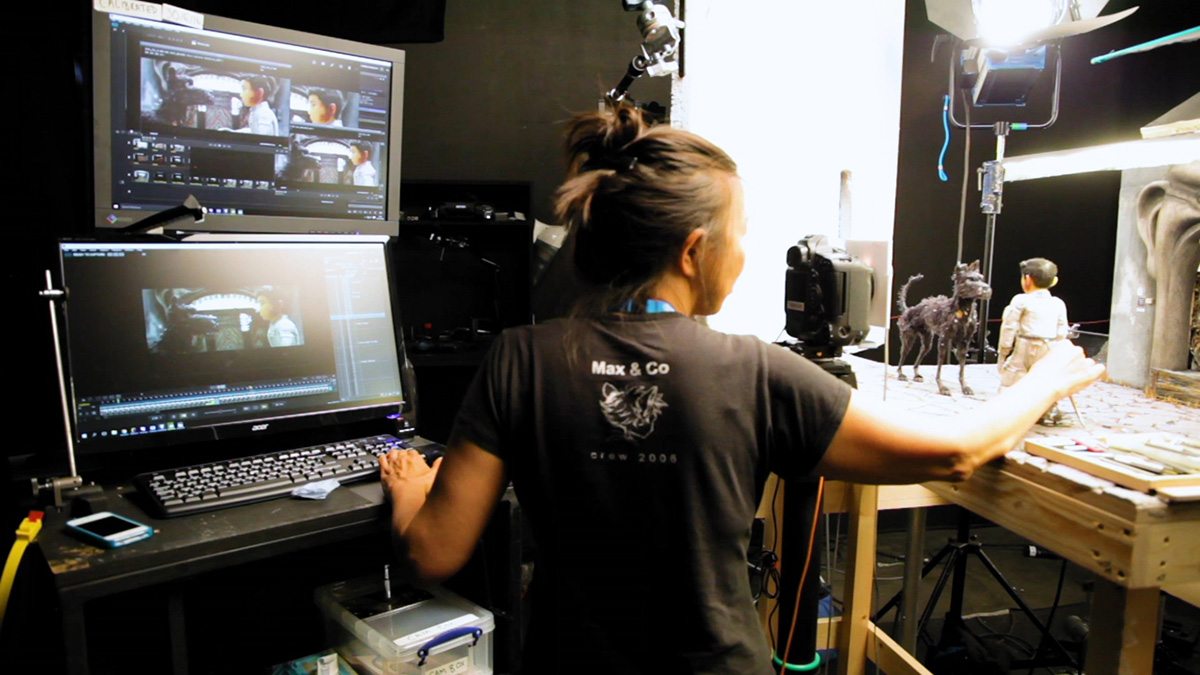
You also need to actually hold focus in a realistic way on the character, so we’re normally working right up against the minimum focal point at the lens. That compromises the depth of field enormously, so we tend to work at a very substantial aperture right down to tiny, almost pinhole photography apertures, in order to give what we shoot the appearance of something shot at a much wider aperture in a full scale environment.
Some people say they can ‘tell’ a Wes Anderson film – are there some major conventions when you’re framing characters and lighting sets when working on one of his films?
Tristan Oliver: Yes, completely. If you sign on to do a Wes Anderson film, you will make a Wes Anderson film. And if you believe that you have the ability to turn that ship around, then you’re a fool. You work within a highly strict set of rules, really. So the framing is very, very symmetrical. You rarely get anything that could be called an angle other than 90 degrees or nought degrees, so a character is either facing camera or is in full profile to camera. The frame is always precisely divided whether that be in halves, thirds, quarters, fifths, sixths, et cetera. The placing of items within that frame very much map that grid. He’s not keen on major things within the frame crossing each other, so he likes to have air around objects so that you have individual reads across characters. He occasionally breaks that, but not often.
Wes likes to use very, very wide lenses with as much depth of field as he can get. So immediately, this becomes a problem because we’re already pushing the physics of what we’re trying to do. And to get the depth of field he’s used to in live action is essentially impossible for us.
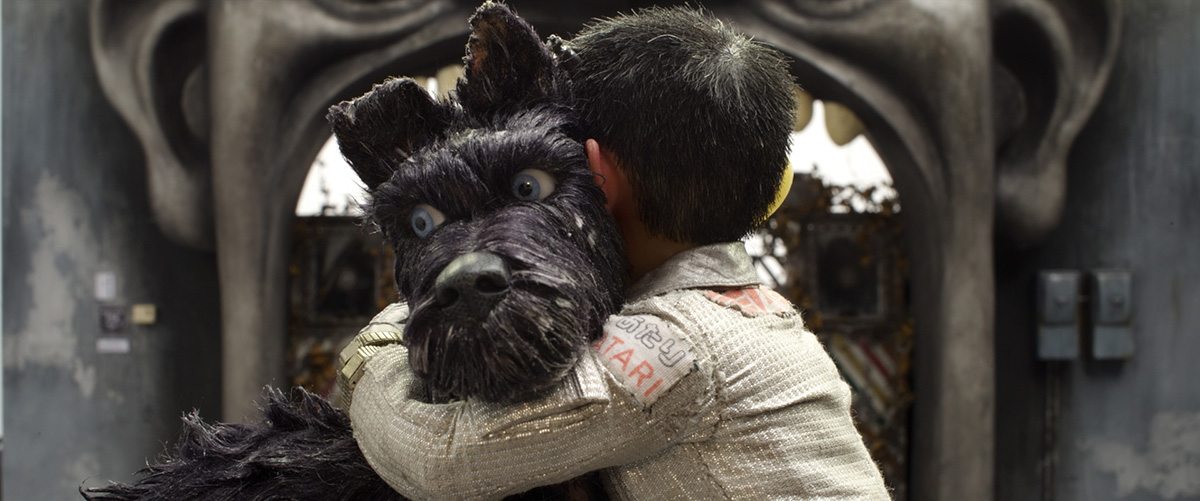
The other thing, which he was driving harder and harder, was the super flat lighting, especially for exteriors. So we almost did away with any directional sunlight outside or even moonlight. In a way, we’ve come full circle, because everything we were trying to drag our bones away from 25 years ago, which was the children’s television stop-frame look of just having a big soft light over the top is kind of what we’re coming back around to working with Wes.
I think what he wants to achieve is something that’s very much a storybook, illustrative quality to things. And so you turn a page, and you’re presented with a beautiful image with lots going on in it that you can let your eye wander around. And then you turn the page again, and there’s another beautiful image, which may or may not have any continuity with the image you did before that.
How did your job work on a day-to-day basis – what were you doing as director of photography?
Tristan Oliver: My crew is ostensibly composed much like any other camera crew. There’s a director of photography. There are camera assistants. There’s a gaffer. There’s ‘sparks.’ There’s motion control operators, and I also have a couple of other guys who light for me. The set comes in to a cleaned out stage. The art department go in. The set is dressed, painted. The camera crew goes in. The camera is set up. The set is lit. The motion control is programmed. And the lighting changes are programmed. This is all inside a giant feedback loop with Wes, of course. He’s getting a work in progress of what we’re doing, so that he can tweak as we go.
Then the animator will go in, and they are completely on their own, so the crew pulls out. Everything comes down to one button, essentially. They hit the button and Dragonframe does the rest really. It does the DMX, which are the lighting changes. It triggers the motion control. It also gives them a running idea of where their lip sync is. And if anything goes wrong, if a light goes out, if the motion control fails to trigger, they just grab a walkie talkie, and scream. And one or other of us will go in and sort it out.
There’s an incredible scene which is the sushi making sequence, can you talk a little about the lighting and set-up for that?
Tristan Oliver: That really is a Wes Anderson classic shot. It’s a top-down shot of the preparation of the food, which he tends to put in nearly all his movies. The actual work with the knife in the hands across the octopus and the fish, that sort of stuff. That was very, very simply lit. That was just really a light box, a wrapped light around the sides and over the top to give this almost completely shadowless flat light, again just to present this highly graphic image.
But it took months and months and months to shoot, because the detailing on the action was so specific from Wes. And what you see in the movie is actually about half of what we shot. I can just imagine the tears shed by those animators when they saw how much had been cut. And we had lots and lots of live-action reference footage by various national treasure sushi chefs from Japan doing this stuff. And of course, quite a lot of the armaturing – a lot of the armaturing for the fish and the octopus was quite complicated just to get them to do what they had to do as they had their last fit of life before being chopped up.
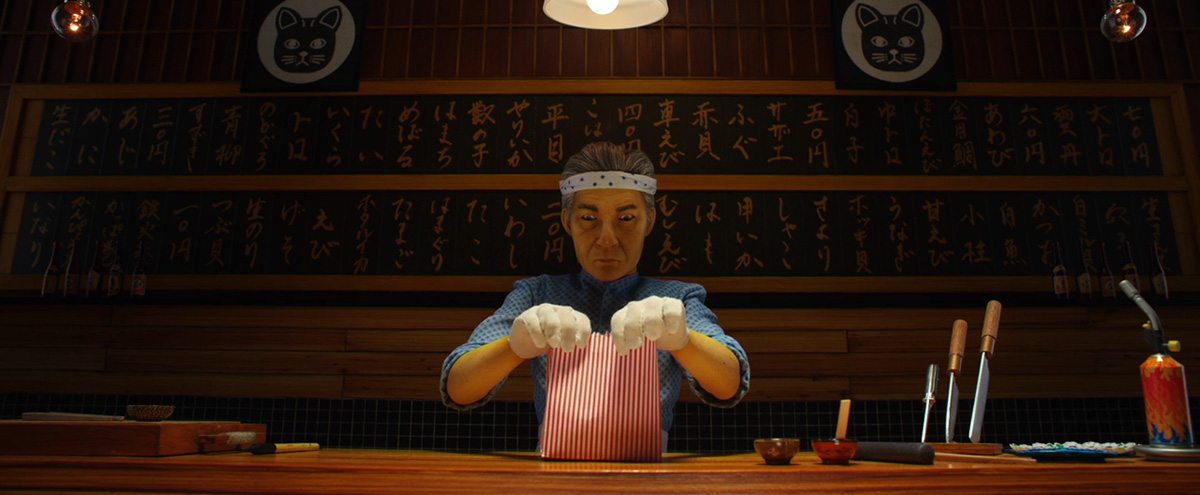
And then the interstitial shots in that, which are actually in the sushi bar, which was a completely different thing. Everything you see being prepared was large, so the hands were almost human sized, working with a large prop. And then you come down to that rather jewel-like, much darker set, with the sushi chef. He’s a normal size puppet. Again, it was about this sense of one shot necessarily having to be exactly continuous with another shot, that very dark, moody, almost spotless interior cuts with that super flat, quite bright, top down closeup of what that guy is doing.
In terms of preparation, it was really the simplest possible lighting to facilitate some extremely intensive animation, because one thing you don’t want to do with an animator is for them to be uncomfortable. That’s another thing with the difference between live action and animation, is that whatever we do, as a camera department, we have to allow set access. We don’t want to be boiling the animator by putting some inappropriately large light a foot from their head.
